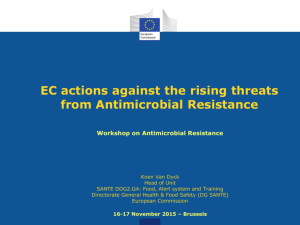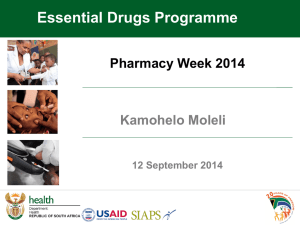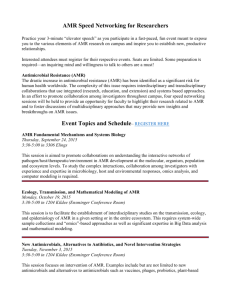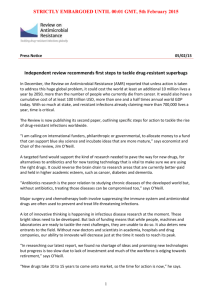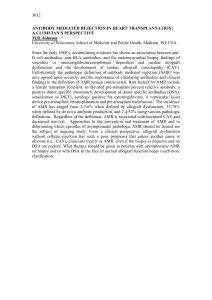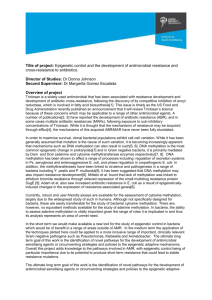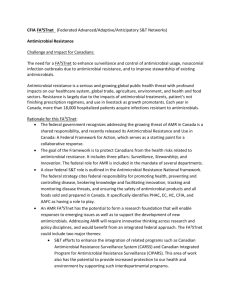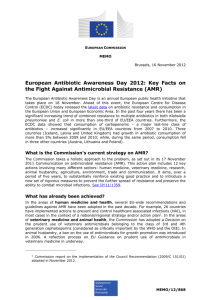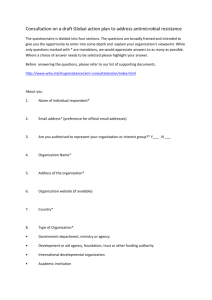Diapositive 1
advertisement
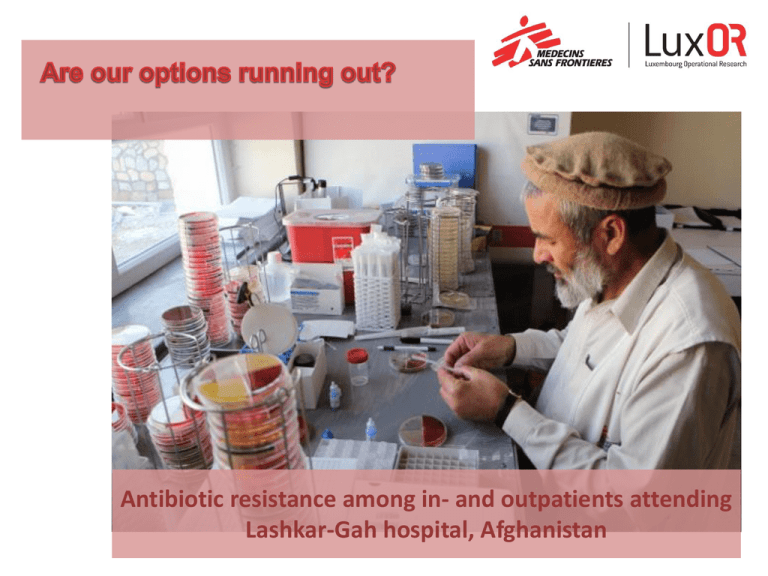
Antibiotic resistance among in- and outpatients attending Lashkar-Gah hospital, Afghanistan Antimicrobial resistance • Antimicrobial resistance (AMR) is defined as “resistance of a microorganism to an antimicrobial drug that was originally effective for treatment of infections caused by it” • It represents a considerable public health threat: – Requires longer and more expensive treatment – Negatively affects patient outcomes – Erodes our armamentarium of drugs against microorganisms Global context • Poor availability of AMR data all over the world, especially in developing country settings • Suspicions that Asia has the highest level of AMR • Current consensus about a clear correlation between anarchic, unregulated use of antibiotics and levels of AMR Afghan context • Unregulated market of antibiotics (subquality, selfmedication…) • High pressure from patients to obtain antibiotics from the prescriber (often IV drugs!) • Over-prescription in hospitals AND private practice • Suspected therapeutic failures in MSF-Hospital MSF-Afghanistan context: Poor therapeutic outcomes… Lashkar Gah Hospital (Helmand) In Lashkar-Gah hospital (Helmand): Unexplained high paediatric mortality rates MSF-Afghanistan context: Overuse of antibiotics… Over-prescriptions of antimicrobial drugs among all outpatient consultations Cf. study Sahar Bajis: “Antimicrobial use in a district hospital in Kabul, Afghanistan – are we too high?“ Ahmad Shah Baba hospital (Kabul): How to assess AMR reality? How to collect data? Option 1? Install a bacteriology lab for routine bacteriology and … be patient 2-3 years to obtain aggregated data? Option 2? Collect enough bacteria from voluntary inhabitants (such as in- and outpatients of an « MSF-hospital ») and screen for resistance… 4 months We’ve chosen Option 2 … for a first statement Methods • Study conducted in Lashkar-Gah hospital (Helmand), Afghanistan • Screening of normal flora was chosen • Adult and paediatric in- and outpatients requested to provide a stool and/or nasopharyngeal swab sample • Bacteria cultured from these samples and tested for AMR Screening of normal flora - limitations • Everyone of us is carrying thousands of millions of bacteria. We are reservoirs. • Sepsis is the most often due to an intrusion of one of these bacteria in our bloodstream. • The bacteria we “carry” can be used as indicators for levels of AMR among pathogenic bacteria. HOWEVER… this is not the same as resistance testing of pathogens in a routine laboratory RESULTS Bacterial species isolation • Screening of normal flora: Participants recruited IPD / OPD Adult / Paediatric 2077 Stool samples 692 Nasopharyngeal swabs 1762 482 E. coli isolates 173 S. pneumoniae isolates 447 Enterococcus species isolates 115 H. influenzae isolates 259 S. aureus isolates Levels of AMR E. coli as indicator species: proportion of patients with a resistant organism (N=114) Tigecycline Others. Nitrofurantoin Chloramphenicol Netilmicine Imipenem Meropenem Amikacine Amino Quinol. glycos. Cefoxitin Amoxi / Clav E S B L Pipera / Tazo ß-Lactamins How to become an AMR specialist? Interpretation of resistance in a population of species ONLY SUSCEPTIBLE STRAINS A nice bell curve taking place on the right of the graph 0% R A FEW RESISTANT STRAINS 8% R Imperfect bell curve + shifting to the left (diameters becoming smaller) shift MAINLY RESISTANT STRAINS 80% R Bell curve has disappeared Most of the strains are on the left E. coli: Penicillins & ß-lactamase inhibitors R R S S R R I I S S R R S I S C2 E. coli & Cephalosporins S R C3 I R I R R S I S S Cephamycines R S C4 R I S R E. coli & Quinolones Ofloxacine Ciprofloxacine Levofloxacine Moxifloxacine I S E.coli & Aminoglycosides Gentamicine Tobramycine Netilmicine Amikacine R I S E. coli & Penems Imipenem R I S R I S Meropenem E. coli & other antibiotics Chloramphenicol R S Tigecycline R I S Resistance in S. pneumoniae (N=64) Screening by oxacilline shows a decreased susceptibility to penicillin MICs to Penicillin could be tested: 16 strains were oxa-R…. MIC values are <= 2 mg/l Thus: decreased susceptibility, but no high level of resistance Discussion • A wake-up call to MSF: our protocols and standard treatment guidelines risk to be outdated ? Discussion • Diagnosis of AMR under field conditions is a bottle-neck – study shows the feasibility of laboratory screening of AMR in normal flora, but not as matter of routine => Haemoculture as routine feasible? • Holistic management of AMR (rational drug use, infection control, improved diagnostics) is required to avert public health disaster Lashkar Gah team July 2013 In MSF-compound Thanks to everybody ! It has been a incredible challenge not possible without a huge involvement of everyone ! Boost Hospital Lashkar Gah Special thanks Health promotion: Caroline Zahndt Abdul Bashir And all their wonderful TEAM! Management: Catherine Van Overloop Gabriele Rossi (« SuperMedco ») Gbane (« huge support for end phase ») LuxOR: Rafael Van den Bergh Rony Zachariah And all the TEAM! OCB-Medical Depatment: Michel Van Herp Pascale Chaillet MSF-Supply Diana & Sonia Lab: Dr Wardak Bismillah Sher Agah Baryalai Logistics / Supply: Ann, Ben, Ryan, Antoine, Bazir, … Sorry for anyone I would have forgotten !!!!

